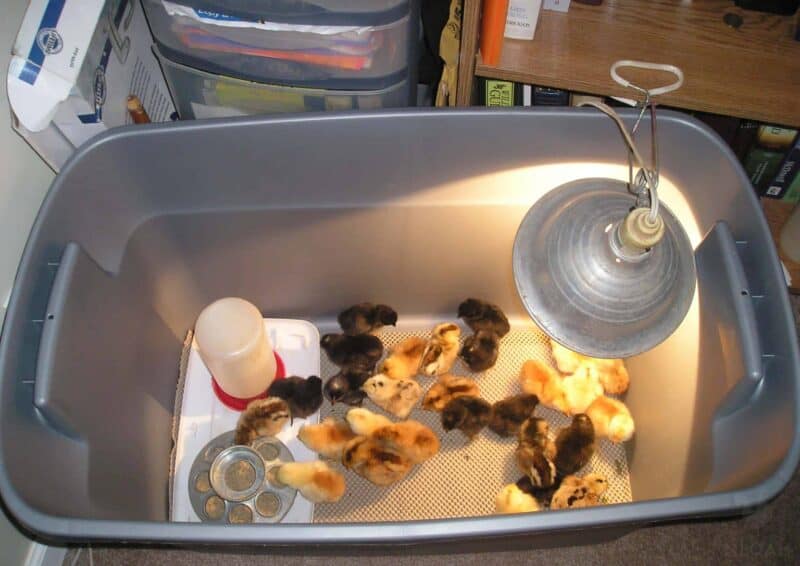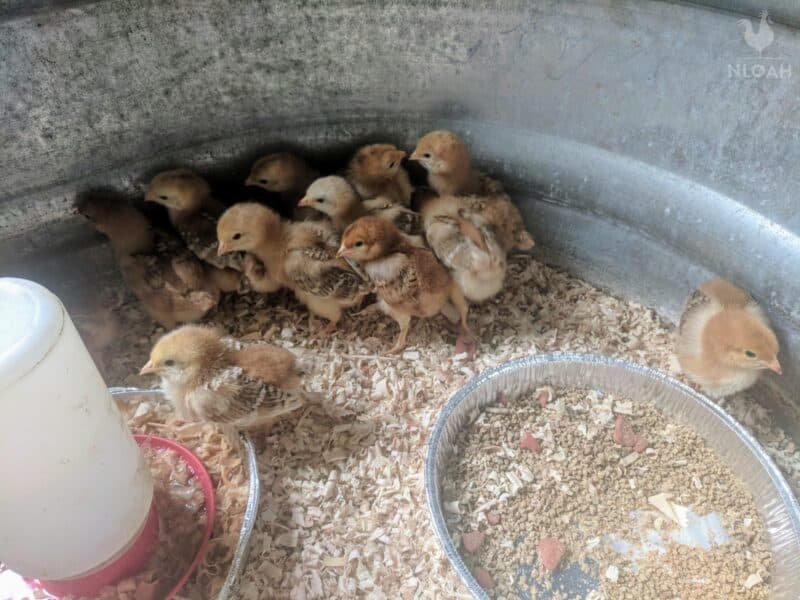Bringing home a bundle of baby chicks, or hatching them yourself, is always an exciting time, but it is a perilous one, too. Chicks are incredibly delicate, and very easy to sicken or even kill accidentally. Not enough water, not enough food, and, arguably most important of all, not enough warmth.

If your baby chicks get too cold for even a short time they will get sick and die quickly. Keeping them warm is critical, and so is this vital question: how warm should you keep your chicks?
Chicks must be kept at 95°F (35°C) or a little warmer for the first week of life, but can tolerate temperatures that are 5° cooler every week thereafter until they are about 7 weeks old. Then they are fully feathered and ready to live outside normally.
I’ve seen too many times chicks get sick, suffer and die because owners negligently or ignorantly let them get too cold. Even being taken outside in the middle of summer can chill them when they are young, as can exposing them to drafts!
You have to do whatever is necessary to keep your chicks warm enough, and I’ll help you do that down below.
Chicks Must Stay Very Warm Early in Life!
Most important of all, as soon as chicks hatch, they must be kept quite warm. This is an incredibly vulnerable time for the hatchlings, as their ability to regulate their own body temperature is not fully developed and even a slight chill can harm or kill them.
95°F is the correct temperature during the first week, and they should not be taken away from their heat source for more than a couple of minutes at most, even inside your home. Proper warmth not only ensures their safety but also promotes healthy development as they grow.
A Chilled Chick is a Dead Chick
Do not underestimate how deadly a chill can be for chicks, even after they pass those first few dangerous days, and even the first 2 weeks of life. Cold air, and especially cold, moist air, is your single biggest enemy.
Your typical temp inside your home is likely not enough for comfort or safety, and drafts coming from air conditioning ducts, open windows or doors in the summer, and leaky walls can be downright deadly.
To prevent this, make sure to keep your chicks in a warm and draft-free environment, and be doubly sure they won’t be exposed to drafts from cold sources like refrigerators and freezers, or outside air in the fall and winter.
What Temperature Do You Need to Keep the Brooder At?
Your brooder should be set at a temperature according to the age of your chicks and their requirements. However, it must not be uniformly hot or warm; chicks need the opportunity to move into a cooler zone within the brooder space.
A temperature gradient is ideal for chicks to self-regulate their body temperature and find comfort at different times.
The following chart will show you what the temp should be inside the brooder week by week in a chick’s life:
| Age of Chick | Temperature | Notes |
| 1st Week | 95-100°F | Require constant hot temperature for optimum health and survival. |
| 2nd Week | 90°F | Can withstand slightly cooler temperatures; start of temperature decrease. |
| 3rd Week | 85°F | Can handle 85°F and slightly cooler for short periods; may explore outside if warm. |
| 4th Week | 80°F | Can handle mild weather; more time outside is okay as they approach adolescence. |
| 5th Week | 75°F | Extended forays outside okay; can tolerate somewhat cooler weather. |
| 6th Week | 70°F | Nearly fully feathered; capable of handling 70°F. |
| After 6 Weeks | Any | Fully feathered; can handle true cold as well as adult chickens. |
Note that it’s important to reduce the temp in increments, gradually, not all at once week to week. A good rule of thumb is to drop the temp by 1 degree every other day during the week, but keep an eye on their behavior to verify they aren’t too cold or hot.
Establishing the Right Brooder Temperature
To adjust the temperature inside the brooder, you’ll need a heat lamp or an infrared chick heater. Just make sure to follow the manufacturer’s instructions on both when connecting and setting them up, and take precautions to prevent fires.
Make doubly sure that they cannot fall into the brooder! Position them above the brooder at a height that will provide the necessary temperature according to your chicks’ needs, and remember to avoid “blanketing” the entirety of the brooder in radiant heat; chicks must be able to move away and cool down when desired.
Use a Thermometer to Accurately Assess Brooder Temp
Guessing won’t do when striving to keep your chicks comfortably and safely warm. To accurately measure the temp in the brooder, and across its various zones, you’ll need to use a thermometer. Make sure to place the thermometer at chick level, as this is where they will be.
An accurate and quick-reading digital thermometer will make the job easier. Check it regularly, and consider one with an alarm if you aren’t going to be nearby to tend to your chicks all the time.

How Can You Tell When a Chick is Too Cold?
Luckily, chick behavior is a reliable indicator of their comfort level. When chicks are too cold, they will huddle closely together under any heat source, emitting distressed and increasingly urgent peeping sounds.
Either is a clear sign that the temperature is too low for comfort and can be creeping into the danger zone.
Also, lethargy and total unwillingness to move away from the heat lamp even for food and water are indicators of a seriously chilly environment.
In extreme cases, chicks may attempt to pile on top of each other to get what warmth can be had. This is perilous as it can lead to suffocation or crushing.
Being alert to this chick behavior is crucial; it will let you know if adjustments to the heat source or other environmental factors are necessary to maintain the right temp.
Watch for Overheating, Too
Just as vital as recognizing the signs of cold stress in chicks, understanding of the symptoms of overheating is critical for safety. This is more common than you might think, and often occurs when you make a mistake with your heat source or when something malfunctions.
When chicks are too hot, they spread and sprawl widely around the brooder, trying to gain personal space and cool off.
Open beaks, nodding heads, and holding their wings away from their bodies are classic signs of heat stress. Also, hot chicks usually stop peeping, so if things are too quiet, you might have a problem.
It’s easy enough to cool chicks off by adjusting the heat source, getting them a little moving air and, if needed, removing them for a short time to let things cool down.
Be cautious of temperature shock, though. Also, prolonged exposure to high temperatures can cause dehydration, so ensure they have fresh water.
In the aftermath of overheating, chicks might show a lack of appetite and reduced growth rates. In severe cases, overheating can cause sudden mortality even when it seems like the danger is past. Again: watch the thermometer and check on chicks continually!
When Can Chicks Leave the Brooder?
Chicks can leave the brooder as early as the first week, but only for minutes at a time when you need to check them (i.e. for pasty butt, etc.) They shouldn’t be taken out on adventures in or around your home at this time.
More practically, chicks are ready for short forays out of the brooder and outside around weeks three to four- but only if it is warm outside! See the chart above. This is when they are usually developed enough to withstand a little cool.
When are Chicks Ready to Go Outside Permanently?
Chicks are truly ready to leave the brooder war join the rest of the flock outside after week 6. This is when they have fully feathered out for maximum insulation, have a metabolism that can keep them warm and can generally regulate their own body temperature and endure harsh conditions without dropping dead.
Do Different Chick Breeds Have Different Temperature Requirements?
No. Even though adult chickens show different levels of tolerance for heat and cold according to their breed, when they are chicks the temperature should always be kept within the range detailed above.
Your little ones will take on the characteristics of adults in just about a month and a half, and then they will cope with extreme temps in the same way.
Tom has lived and worked on farms and homesteads from the Carolinas to Kentucky and beyond. He is passionate about helping people prepare for tough times by embracing lifestyles of self-sufficiency.
